-
 Bitcoin
Bitcoin $106,754.6083
1.33% -
 Ethereum
Ethereum $2,625.8249
3.80% -
 Tether USDt
Tether USDt $1.0001
-0.03% -
 XRP
XRP $2.1891
1.67% -
 BNB
BNB $654.5220
0.66% -
 Solana
Solana $156.9428
7.28% -
 USDC
USDC $0.9998
0.00% -
 Dogecoin
Dogecoin $0.1780
1.14% -
 TRON
TRON $0.2706
-0.16% -
 Cardano
Cardano $0.6470
2.77% -
 Hyperliquid
Hyperliquid $44.6467
10.24% -
 Sui
Sui $3.1128
3.86% -
 Bitcoin Cash
Bitcoin Cash $455.7646
3.00% -
 Chainlink
Chainlink $13.6858
4.08% -
 UNUS SED LEO
UNUS SED LEO $9.2682
0.21% -
 Avalanche
Avalanche $19.7433
3.79% -
 Stellar
Stellar $0.2616
1.64% -
 Toncoin
Toncoin $3.0222
2.19% -
 Shiba Inu
Shiba Inu $0.0...01220
1.49% -
 Hedera
Hedera $0.1580
2.75% -
 Litecoin
Litecoin $87.4964
2.29% -
 Polkadot
Polkadot $3.8958
3.05% -
 Ethena USDe
Ethena USDe $1.0000
-0.04% -
 Monero
Monero $317.2263
0.26% -
 Bitget Token
Bitget Token $4.5985
1.68% -
 Dai
Dai $0.9999
0.00% -
 Pepe
Pepe $0.0...01140
2.44% -
 Uniswap
Uniswap $7.6065
5.29% -
 Pi
Pi $0.6042
-2.00% -
 Aave
Aave $289.6343
6.02%
Is the death cross of EMA5 and EMA10 a short-term sell signal?
The EMA5/EMA10 death cross in crypto suggests short-term bearish momentum but requires confirmation from volume and other indicators to improve reliability.
Jun 14, 2025 at 06:28 pm
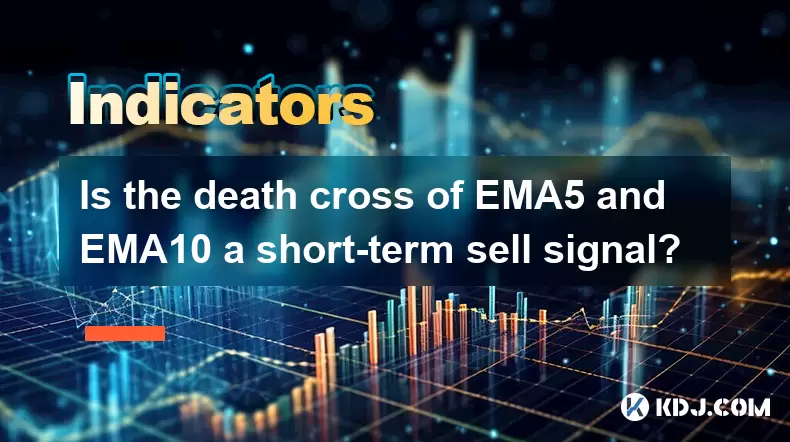
Understanding the Death Cross in Cryptocurrency Trading
In cryptocurrency trading, technical indicators play a crucial role in decision-making. One such signal is the death cross, which occurs when a short-term moving average crosses below a long-term moving average. Specifically, the EMA5 (Exponential Moving Average of 5 periods) crossing below the EMA10 (Exponential Moving Average of 10 periods) can be interpreted by some traders as a bearish signal. This pattern has been historically associated with potential downtrends in traditional markets and is often analyzed within crypto circles for short-term trading decisions.
The EMA5/EMA10 death cross should not be viewed in isolation. It must be evaluated alongside volume, price action, and other indicators to increase its reliability.
How the EMA Death Cross Works
The Exponential Moving Average gives more weight to recent prices, making it more responsive to new information compared to simple moving averages. When the EMA5 crosses below EMA10, it suggests that short-term momentum is shifting downward.
- Identify EMA5 and EMA10 on your charting platform: Most platforms like TradingView or Binance allow users to add these indicators easily.
- Set the time frame: For short-term signals, use 1-hour or 4-hour charts to capture immediate trends.
- Observe the crossover point: Look for the moment when the green line (EMA5) dips below the red line (EMA10).
- Check volume levels: A strong bearish signal usually comes with increased selling volume during the crossover.
This crossover does not guarantee a downtrend but indicates weakening bullish pressure.
Historical Examples in Crypto Markets
There have been instances in major cryptocurrencies like Bitcoin and Ethereum where the EMA5/EMA10 death cross preceded short-term corrections. For example, in early 2022, Bitcoin's hourly chart showed multiple EMA5/EMA10 death crosses before sharp drops. Similarly, Ethereum experienced similar patterns during volatile pullbacks.
However, not all crossovers led to significant declines. In some cases, the market rebounded quickly, nullifying the bearish signal. These inconsistencies highlight the need for additional confirmation tools.
Combining the Death Cross with Other Indicators
Relying solely on the EMA5/EMA10 death cross can lead to false signals. Traders often combine this with other technical tools to improve accuracy.
- RSI (Relative Strength Index): If the RSI is above 70 and starts to drop along with the death cross, it strengthens the sell signal.
- MACD (Moving Average Convergence Divergence): A bearish MACD crossover occurring at the same time increases confidence in the downtrend.
- Support and resistance levels: If the death cross happens near a known resistance level, the probability of a reversal increases.
- Volume indicators: Use On-Balance Volume (OBV) or Chaikin Money Flow (CMF) to confirm whether institutional selling is happening.
These combinations help filter out noise and provide a clearer picture of market sentiment.
Practical Application: How to Trade the Death Cross
If you're considering using the EMA5/EMA10 death cross as a short-term sell signal, here’s how to implement it effectively:
- Select a cryptocurrency pair: Preferably BTC/USDT or ETH/USDT due to their high liquidity and clear trend patterns.
- Apply EMA5 and EMA10 on the chart: Ensure both are set correctly and visible.
- Wait for the crossover: Do not act immediately—wait for the candle to close below the EMA10 to avoid fakeouts.
- Place a sell order: You may place a limit order slightly below the closing price to ensure execution.
- Set a stop-loss: Place it above the nearest swing high to protect against sudden reversals.
- Monitor exit points: Consider exiting once a certain profit target is reached or if another crossover (golden cross) appears.
This strategy works best in trending or consolidating markets rather than highly volatile ones.
Frequently Asked Questions
Q: Is the EMA5/EMA10 death cross reliable for altcoins?
A: The reliability varies depending on the altcoin’s liquidity and volatility. Major altcoins like SOL or ADA tend to follow the pattern better than smaller-cap tokens.
Q: Can I use the death cross on daily charts for longer trades?
A: Yes, although the EMA5/EMA10 death cross is typically used for intraday trading, it can also indicate potential medium-term shifts when observed on daily charts.
Q: What if the death cross appears but the price continues to rise?
A: This is called a false signal. It often occurs in sideways or choppy markets. Always check for confluence with other indicators before taking action.
Q: Should I always exit my position after a death cross?
A: Not necessarily. Some traders use trailing stops or partial exits instead of closing the entire position immediately.
Disclaimer:info@kdj.com
The information provided is not trading advice. kdj.com does not assume any responsibility for any investments made based on the information provided in this article. Cryptocurrencies are highly volatile and it is highly recommended that you invest with caution after thorough research!
If you believe that the content used on this website infringes your copyright, please contact us immediately (info@kdj.com) and we will delete it promptly.
- 2025-W Uncirculated American Gold Eagle and Dr. Vera Rubin Quarter Mark New Products
- 2025-06-13 06:25:13
- Ruvi AI (RVU) Leverages Blockchain and Artificial Intelligence to Disrupt Marketing, Entertainment, and Finance
- 2025-06-13 07:05:12
- H100 Group AB Raises 101 Million SEK (Approximately $10.6 Million) to Bolster Bitcoin Reserves
- 2025-06-13 06:25:13
- Galaxy Digital CEO Mike Novogratz Says Bitcoin Will Replace Gold and Go to $1,000,000
- 2025-06-13 06:45:13
- Trust Wallet Token (TWT) Price Drops 5.7% as RWA Integration Plans Ignite Excitement
- 2025-06-13 06:45:13
- Ethereum (ETH) Is in the Second Phase of a Three-Stage Market Cycle
- 2025-06-13 07:25:13
Related knowledge
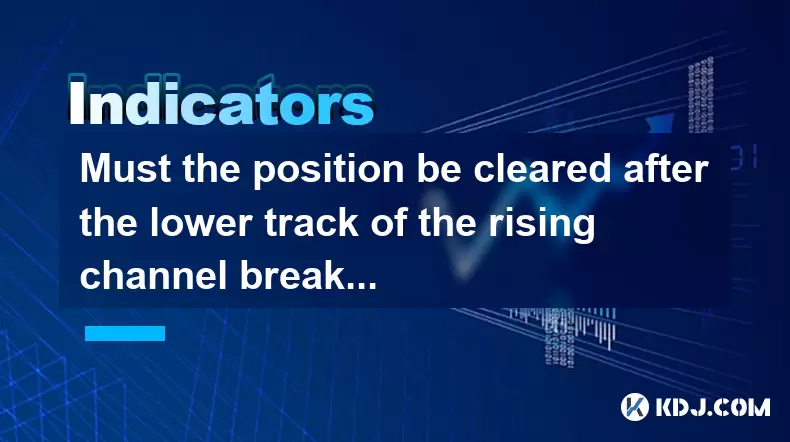
Must the position be cleared after the lower track of the rising channel breaks?
Jun 16,2025 at 04:43pm
Understanding the Rising Channel BreakdownIn technical analysis, a rising channel is formed by drawing two parallel trendlines: one connecting higher lows and another connecting higher highs. When the price breaks below the lower trendline of this channel, it signals a potential reversal or at least a pause in the uptrend. This event often triggers trad...
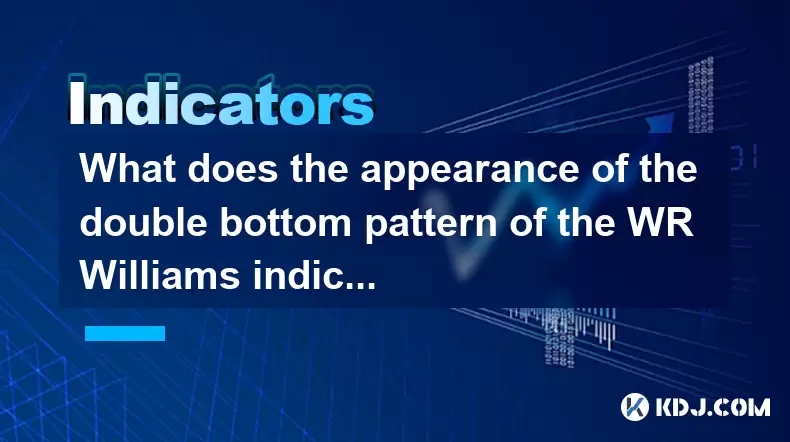
What does the appearance of the double bottom pattern of the WR Williams indicator mean? Can I buy the bottom?
Jun 16,2025 at 01:01pm
Understanding the WR Williams IndicatorThe WR (Williams %R) is a momentum oscillator used in technical analysis to identify overbought and oversold levels in trading. Developed by Larry Williams, this indicator oscillates between 0 and -100. A reading above -20 typically indicates overbought conditions, while a reading below -80 signals oversold territo...
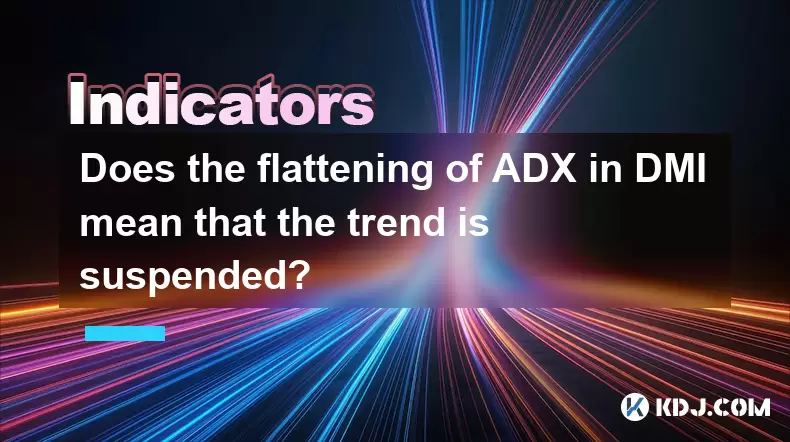
Does the flattening of ADX in DMI mean that the trend is suspended?
Jun 16,2025 at 02:07pm
Understanding the ADX and DMI IndicatorsThe ADX (Average Directional Index) is part of the DMI (Directional Movement Index) system developed by J. Welles Wilder to measure trend strength. The DMI itself consists of three components: the +DI (Positive Directional Indicator), -DI (Negative Directional Indicator), and the ADX line. While the +DI and -DI he...
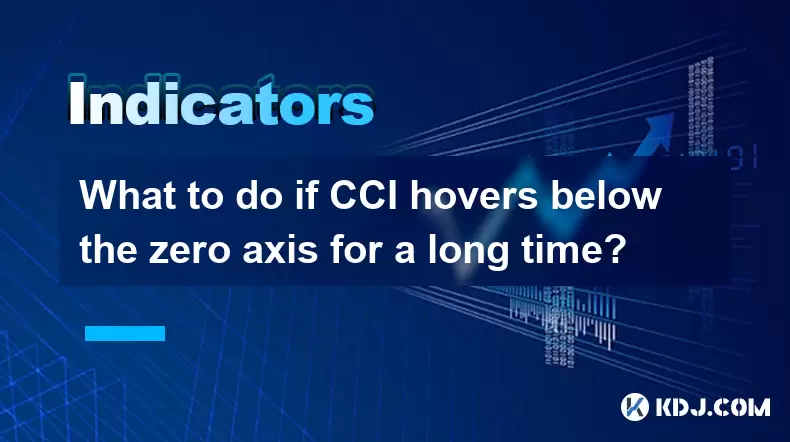
What to do if CCI hovers below the zero axis for a long time?
Jun 16,2025 at 04:05pm
Understanding the CCI Indicator in Cryptocurrency TradingThe Commodity Channel Index (CCI) is a versatile technical indicator used extensively in cryptocurrency trading to identify overbought or oversold conditions, as well as potential trend reversals. When the CCI hovers below the zero axis for an extended period, it can signal a prolonged bearish sen...
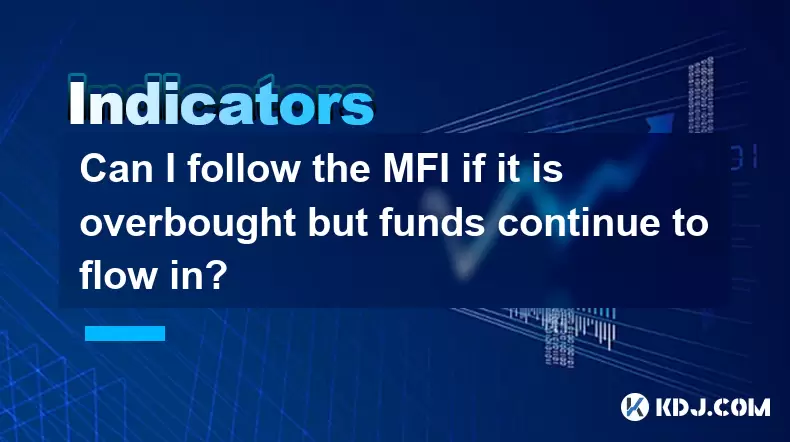
Can I follow the MFI if it is overbought but funds continue to flow in?
Jun 16,2025 at 03:07pm
Understanding the MFI Indicator in Cryptocurrency TradingThe Money Flow Index (MFI) is a technical indicator used extensively in cryptocurrency trading to measure buying and selling pressure. It combines price and volume data to assess overbought or oversold conditions. Typically, an MFI reading above 80 indicates overbought territory, while below 20 su...
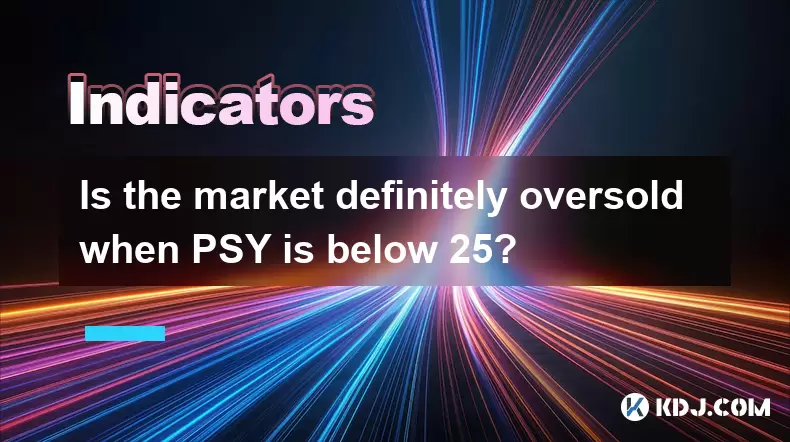
Is the market definitely oversold when PSY is below 25?
Jun 16,2025 at 03:43pm
Understanding the Psychological Line (PSY) IndicatorThe Psychological Line (PSY) is a momentum oscillator used in technical analysis to gauge investor sentiment. It measures the ratio of days when the price closes higher versus the number of days it closes lower over a specific period, typically 12 or 25 trading days. The resulting value ranges from 0 t...

Must the position be cleared after the lower track of the rising channel breaks?
Jun 16,2025 at 04:43pm
Understanding the Rising Channel BreakdownIn technical analysis, a rising channel is formed by drawing two parallel trendlines: one connecting higher lows and another connecting higher highs. When the price breaks below the lower trendline of this channel, it signals a potential reversal or at least a pause in the uptrend. This event often triggers trad...

What does the appearance of the double bottom pattern of the WR Williams indicator mean? Can I buy the bottom?
Jun 16,2025 at 01:01pm
Understanding the WR Williams IndicatorThe WR (Williams %R) is a momentum oscillator used in technical analysis to identify overbought and oversold levels in trading. Developed by Larry Williams, this indicator oscillates between 0 and -100. A reading above -20 typically indicates overbought conditions, while a reading below -80 signals oversold territo...

Does the flattening of ADX in DMI mean that the trend is suspended?
Jun 16,2025 at 02:07pm
Understanding the ADX and DMI IndicatorsThe ADX (Average Directional Index) is part of the DMI (Directional Movement Index) system developed by J. Welles Wilder to measure trend strength. The DMI itself consists of three components: the +DI (Positive Directional Indicator), -DI (Negative Directional Indicator), and the ADX line. While the +DI and -DI he...

What to do if CCI hovers below the zero axis for a long time?
Jun 16,2025 at 04:05pm
Understanding the CCI Indicator in Cryptocurrency TradingThe Commodity Channel Index (CCI) is a versatile technical indicator used extensively in cryptocurrency trading to identify overbought or oversold conditions, as well as potential trend reversals. When the CCI hovers below the zero axis for an extended period, it can signal a prolonged bearish sen...

Can I follow the MFI if it is overbought but funds continue to flow in?
Jun 16,2025 at 03:07pm
Understanding the MFI Indicator in Cryptocurrency TradingThe Money Flow Index (MFI) is a technical indicator used extensively in cryptocurrency trading to measure buying and selling pressure. It combines price and volume data to assess overbought or oversold conditions. Typically, an MFI reading above 80 indicates overbought territory, while below 20 su...

Is the market definitely oversold when PSY is below 25?
Jun 16,2025 at 03:43pm
Understanding the Psychological Line (PSY) IndicatorThe Psychological Line (PSY) is a momentum oscillator used in technical analysis to gauge investor sentiment. It measures the ratio of days when the price closes higher versus the number of days it closes lower over a specific period, typically 12 or 25 trading days. The resulting value ranges from 0 t...
See all articles

























































































